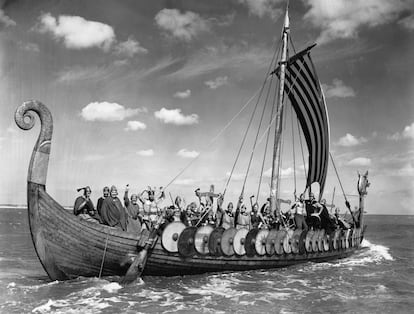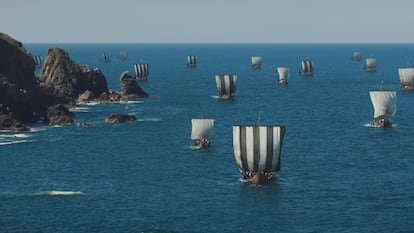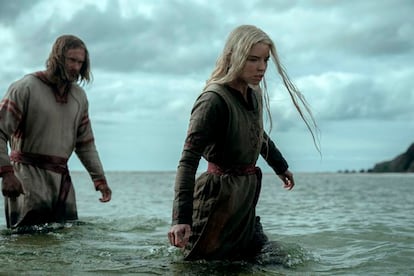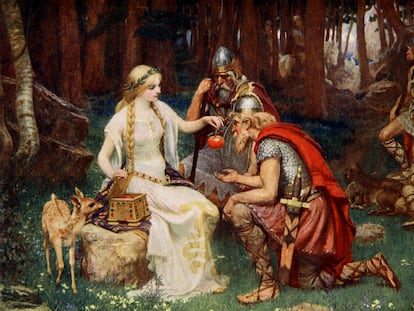Traveler, slaver, and the scourge of walruses, the ‘Black Viking’ sails towards the light
In a fascinating book, the Icelandic researcher Bergsveinn Birgisson reveals the story of his medieval ancestor Geirmundur Hjörsson, forgotten by the sagas


Among the most famous Vikings — Ragnar Lothbrok (meaning Hairy Breeches), Harald Fairhair, Erik the Red — the ninth-century Black Viking, Geirmundur Hjörsson hardly gets a mention. And this despite the fact that he came from a great royal lineage in Norway. He became one of the most important aristocrats in Iceland, owned a large fleet (he was a “king of the sea”), and went on untold adventures, traveling to places in the far north that his imagination had populated with monsters.
All sources indicate that Geirmundur was a very ugly man: More like a troll than a Viking. He received the nickname Heljarskinn (“Black Skin”) derived from Hel, the personification of death in ancient Norse poems, goddess daughter of Loki and the wicked giantess Angurboda (“She who causes sadness”) and who had a blackened complexion like a corpse.
Geirmundur’s ugliness in the eyes of his contemporaries, which actually revealed a puzzling foreign (possibly Siberian) ethnic origin, apparently banished him from traditional stories, the sagas (only a few fragments exist about him), and from the founding chronicle of Iceland, in which he would have played a decisive role. It also didn’t help that the Black Viking was not a famous warrior with great military feats like Harald Hardrada (the Merciless) or the cinematic Einar and Amleth, but that his activity focused on the slave trade (which he ran on a large scale) and walrus hunting, which, it must be agreed, is more difficult to sing about.
In a fascinating book with an Indiana Jones title, The Black Viking — available in English and now also in Spanish — the Icelandic researcher and writer Bergsveinn Birgisson, who is also a 30th generation patrilineal descendant of this mysterious character, delves into history, literature, archaeology, geography, and toponymy (and his own imagination) to bring the life of Geirmundur to light.
By the way, Birgisson, who has a PhD in Scandinavian Medieval Literature and is the author of numerous scientific publications, takes us on a deep dive into Viking society. The book covers all the Viking topics of debate, from Ivar the Boneless’s nickname to the controversy over whether the so-called blood eagle method of execution actually existed. The book’s highlights include the presence of Hallfredr the Troublesome Poet and the priceless history of the Helgafell mountain, which was so sacred that no one should look at it without washing first.
But apart from kinship, why investigate a character who was not a typical Viking? “His story covers the settlement of the Vikings in Iceland, which was a new territory, the maritime hunting economy (a much neglected aspect of Viking studies), and the policies of the aristocrats regarding slavery, on which little research has been done,” Birgisson explains to this newspaper. “Geirmundur also helps to change the stereotypical idea of the Viking. It must be remembered that less than 10% of the population was involved in war and pillage, perhaps even only 5%. The other 95% were merchants, farmers, fishermen, hunters, or people skilled in one craft or another. The modern meaning of Viking today is ‘people who lived in the Viking Age.’ So we have a lot of peaceful Vikings according to that meaning.”
What has caused the Black Viking to fall into oblivion? “Historians of the 12th and 13th centuries point out that he was the noblest, richest, and most powerful of the colonizers of Iceland, but despite this they did not want to write much about him. It’s as if they were saying: ‘We’re not going to forget him completely, but we’re not going to remember him much either.’ The reason is that his activities (large-scale slavery, hunting to extinction, his origins in Siberia, etc.) do not harmonize with the Icelandic founding myth, created by the pioneers of history on the island. “Geirmundur’s story was not the one they wanted to represent the exemplary, egalitarian founding of the country.”
In the book, which mixes his scholarly tone with his passion for research and in some passages happily subverts the conventions of academic writing; in one part Birgisson appeals directly to Geirmundur and we can hear a Viking navigator exclaim: “What a shitty fog!” We also follow the author in his meticulous and enthusiastic detective investigation and his discoveries. Likewise we accompany him on the journeys he makes in search of the elusive Geirmundur, a Viking from eleven hundred years ago whose stamping ground included Norway, the far north of Scandinavia, the northern coast of Russia (the Kola Peninsula, White Sea, Archangel, and the mouths of the Dvina and the Mezen), Ireland, and Iceland.
Birgisson maintains that the Black Viking was the son of a high-born woman captured as booty and made to marry King Hjor of Rogaland in Biarmia or Bjamarland, a territory that appears in the sagas and is believed to be northwest of Russia.
From his “bjarman” mother, who was perhaps a Samoyed (Nenet or Sikhirtian), Geirmundur would have inherited his “black” and “ugly” features — as perceived by Viking society. These would include very dark skin and hair; a flat, rounded face; a snub nose; and the Mongolian fold on the eyelids. This mixed-heritage Black Viking was a full-fledged — and very noble — Viking on his father’s side, but he and his twin brother Hamúndr had to bear the label of “different” and even “half-trolls” due to their maternal racial heritage. His appearance was not enough to inspire a skald, or Viking poet.

Birgisson takes us to Bjarmaland by boat — sensationally reconstructing the expeditions of the time. This was a cold, remote, and dangerous place, but it was also a land of huge opportunities for commerce. The Scandinavians went there to look for walruses (hrosshvalr) in particular, from which they obtained the precious tusks (the only source of ivory since the Europeans’ access to African elephants had stopped), oil (the author has done experiments to extract it), and most notably the ropes that were made from walrus skin (svardreipi) that were essential for Viking ships. Only this type of rope, considered the best in the world, were strong enough to control large sails in difficult conditions.
Hunting walruses was not easy (they weigh up to 1,700 pounds and are not manageable, Birgisson recalls). Surely the Vikings made agreements with the hunting peoples of the area to help them. In this context, Hjor traveled with his son Geirmundur to Bjarmaland and left him there (hardly voluntarily) to learn the techniques from the locals.
Apparently the Black Viking took a wife during his stay. She was a powerful woman, who was possibly a shaman. The knowledge he acquired later served him in his later career as a successful trader of walrus raw material — everything was walrus, from head to tail: even the penis bone was used to make knife handles. In the splendid Beyond The Northlands, Eleanor Rosamund Barraclough explains that even today the Royal Norwegian Polar Bear Society uses a walrus penis bone in the “knighting” ceremony for new members.
Geirmundur prospered after being rescued from his involuntary (but very profitable) Samoyed studies. Birgisson follows him on his travels to Ireland, which coincided with the decline of the Viking kings of Dublin, and then on the decisive expedition to Iceland, which he left in 867 with a group of Vikings, including Úlfur the Cross-eyed, Prándur Skinny Legs, and Steinolfur the Short.
On Iceland, Geirmundur, who had taken a large number of slaves captured in Ireland and perhaps some Bjarman hunters — to whom Birgisson attributes the current existence of Mongol characteristics in Iceland, such as Mongolian fold in the eyes of the singer Björk. Geirmundur settles in the northwest, in the Breidafjördur, a pristine landscape full of walrus, where he organizes massive slaughters of the animals and becomes enormously rich and powerful. He also exploits the highly prized eider feathers in his manor (sixty nests provide two pounds of feathers, enough for a down quilt). A century after the Black Viking, walruses were almost extinct in Iceland.

Among the unique moments in Birgisson’s story is another experiment. This one relates to the legend that in Snorraskjól, a meadow on Geirmundur’s land, a witch’s spell makes every man and woman who passes by feel an irresistible lust. The researcher does the test “as befits a truth-loving scientist” and gets an erection, sorry. “Well yes, it happened,” he writes in an unclassifiable passage. “I cannot explain what the reason for my erection was: whether it was that primitive magical force or my expectations.”
Questioned about the episode, the author considers that “whoever has a sense of humor cannot be completely wrong” and that his way of approaching the book involves presenting himself as a subject, “a man made of flesh and blood who is trying to uncover the history of my ancestor.” His message, he says, is that “you are no less scientific if you accept subjectivity as a fact, as long as you are honest about it.” In any case, he emphasizes that it is not a book written especially for experts” and certainly “not to favor a rigid academic way of thinking.”
“My book is hybrid in form, and the reason is that I want the general public to read it and not just specialists,” says Birgisson, who has published several novels — Reply to a Letter from Helga was an international success. “I am a scholar and a writer, so I want to be a person who uses their brain to the full and not just a part. The book is scientific, but the underlying concept is trying to step into the shoes of someone who lived eleven hundred years ago. It is a project in which certain liberties had to be taken to fill in the gaps in the story. That does not mean fantasizing for the sake of fantasizing, when I imagine something I always make it explicit and cite my sources.”

The scholar believes that Geirmundur had a ship burial in Iceland, and after tracing it suggests that it could be under the church of Skard, where some remains appeared under the altar in the 1980s. It’s an enigmatic ending to the reconstructed saga of the Black Viking.
We are seeing a real avalanche of new scientific and artistic contributions around the Vikings. What does Birgisson find most interesting about all this? “I am very surprised by the new popularity of the Vikings. When I started my studies in the early 1990s, there was a handful of us, and the subject was very marginalized. Perhaps our lives have become so boring that we look back to other times when life was more adventurous. Be that as it may, there are some things, for example in the ethics of Viking culture that we can learn from; they were not a barbaric or primitive culture at all. There are many scholars that I admire and I cannot mention them all. Material culture has been presented quite well by the Vikings series, but if we talk about films, it seems to me that The Northman better addresses the mentality of the time. As for female warriors, there is no mention in the sources, so I consider it a fantasy, although a very good one for a series.
As for what remains to be resolved about the history of the Vikings and their American experience, Birgisson comments: “The mind, mentality, and poetics of those people is what intrigues me the most. I wrote my doctoral thesis on that topic. The settlement of Vikings in America must have been very similar their experience in settling Iceland, or any other territory where the Norse settled. But there was a problem in America and Greenland that there was not in Iceland: other people. And that, it seems to me, is the main reason why the settlement was not successful or permanent.”
Sign up for our weekly newsletter to get more English-language news coverage from EL PAÍS USA Edition








































